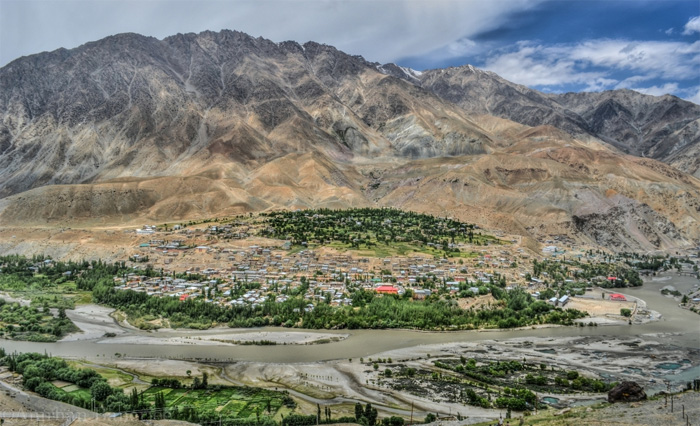|
|
|
 |
 |
|
|
|
|
|
|
 There are conflicting views about the meaning of the name “Kargil” .
Some say it is derived from two words ‘Khar’ and ‘Hrkil’ which means the kingdom in between.
While the others believe that it is derived from the words ‘Gar’ meaning from anywhere and ‘Khil’ meaning stop.
With the passage of time Garkhil became Kargil. Kargil district came in to existence in July 1979, after it was curved out of the erstwhile district Ladakh.
It has a geographical area of 14,036 sqkms, and lies at a distance of about 204 km from its Head Quarter at Srinagar.
The 2011 census figures the population of the district around 1, 23,000 of which 99% belongs to Scheduled Tribe;
and the district presents a composite culture of Balti, Purgi, Dardi, Zanskari and Shia cultures . There are conflicting views about the meaning of the name “Kargil” .
Some say it is derived from two words ‘Khar’ and ‘Hrkil’ which means the kingdom in between.
While the others believe that it is derived from the words ‘Gar’ meaning from anywhere and ‘Khil’ meaning stop.
With the passage of time Garkhil became Kargil. Kargil district came in to existence in July 1979, after it was curved out of the erstwhile district Ladakh.
It has a geographical area of 14,036 sqkms, and lies at a distance of about 204 km from its Head Quarter at Srinagar.
The 2011 census figures the population of the district around 1, 23,000 of which 99% belongs to Scheduled Tribe;
and the district presents a composite culture of Balti, Purgi, Dardi, Zanskari and Shia cultures .
Agriculture and animal husbandry are the main sources of livelihood in Kargil. 91 per cent of the population is engaged in agriculture alone. Wheat and barley are the major crops.
Fruits like apricot, Grapes, Peaches and apple are also grown but with a very less production.
So far the power availability is concerned; it is completely not enough to meet the requirement of the community. Presently there are around 157 villages in Kargil, out of which only 97 villages are electrified (of which 95% through DG Sets).
There are mainly two power stations one small hydro (Iqpal Project) with an installed capacity of 3.75MW and one DG station with 4MW capacity that supplies electricity to the main town of Kargil and villages nearby. There are also two numbers
of mini hydroelectric power units and some DG sets (with capacity ranging from 50-750 KV) mostly installed in the progressive villages.
KREDA , since its inception, has been working hard on several projects with decisive steps to tap immense potential for renewable energy sources such as solar, wind, biomass, small hydro etc. in Kargil, so that the power requirement in the district can be mended and at the same time the contribution of renewable energy, in the total energy generation, can be increased. Renewable energy is a promising resource of energy for the future. The wise harvesting of renewable sources, available in the Region, can reduce the energy scarcity and the cost. Ladakh promises feasible sites for renewable plants of any kind whether it would be Solar, Hydro, Wind or any kind of Hybrid System.
|
| |
|
|
|
|
|
|
|
|
|
|
|
|